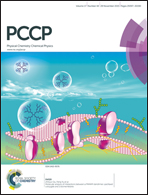Near-ambient XPS characterization of interfacial copper species in ceria-supported copper catalysts†
Abstract
Catalysts based on combinations of copper and cerium oxides are interesting alternatives to noble metal ones for processes involved in the production/purification of hydrogen produced from hydrocarbons or biomass like the water–gas shift or the preferential oxidation of CO reactions. Active sites for such processes have been proposed to correspond to reduced species formed at the interface between both oxides. The present work provides direct evidence of reduced copper species located at the interface and observed during the course of near-ambient XPS experiments performed over samples of copper oxide supported on ceria nanospheres and nanocubes subjected to interaction with CO at different temperatures. The analysis of XPS results is based on DFT+U calculations employed as a complementary method for the analysis of redox properties of the catalysts and core-level shifts produced upon such redox changes. Differences observed in interfacial redox properties as a function of the ceria support morphology appear to be most useful to explain catalytic properties of this type of system for mentioned processes.


 Please wait while we load your content...
Please wait while we load your content...